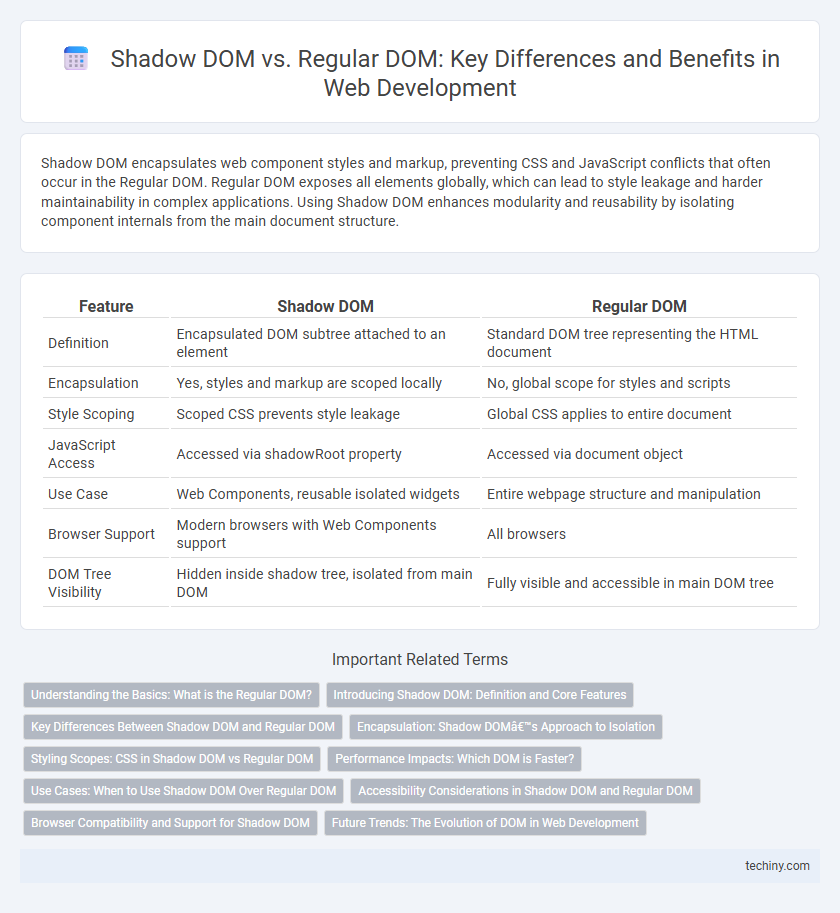Shadow DOM encapsulates web component styles and markup, preventing CSS and JavaScript conflicts that often occur in the Regular DOM. Regular DOM exposes all elements globally, which can lead to style leakage and harder maintainability in complex applications. Using Shadow DOM enhances modularity and reusability by isolating component internals from the main document structure.
Table of Comparison
| Feature | Shadow DOM | Regular DOM |
|---|---|---|
| Definition | Encapsulated DOM subtree attached to an element | Standard DOM tree representing the HTML document |
| Encapsulation | Yes, styles and markup are scoped locally | No, global scope for styles and scripts |
| Style Scoping | Scoped CSS prevents style leakage | Global CSS applies to entire document |
| JavaScript Access | Accessed via shadowRoot property | Accessed via document object |
| Use Case | Web Components, reusable isolated widgets | Entire webpage structure and manipulation |
| Browser Support | Modern browsers with Web Components support | All browsers |
| DOM Tree Visibility | Hidden inside shadow tree, isolated from main DOM | Fully visible and accessible in main DOM tree |
Understanding the Basics: What is the Regular DOM?
The Regular DOM represents the standard Document Object Model where HTML elements are structured in a tree hierarchy, allowing JavaScript to manipulate the entire web page's content and structure directly. It serves as the foundation for rendering and updating user interfaces by reflecting changes immediately across all elements. Unlike Shadow DOM, the Regular DOM lacks encapsulation, which means styles and scripts applied globally can affect any element randomly.
Introducing Shadow DOM: Definition and Core Features
Shadow DOM is a web standard that encapsulates a subtree of DOM elements, providing style and markup isolation from the main document DOM. It enables developers to create reusable components with scoped CSS, preventing style leaks and conflicts. Core features include DOM encapsulation, scoped CSS styling, and encapsulated event handling, enhancing modularity and maintainability in web applications.
Key Differences Between Shadow DOM and Regular DOM
Shadow DOM encapsulates component styles and markup, creating a scoped subtree that prevents CSS and JavaScript conflicts common in Regular DOM structures. Unlike Regular DOM, which exposes elements globally and allows style leakage, Shadow DOM maintains isolated DOM trees enabling better modularity and reusability. This encapsulation improves web component development by enhancing maintainability and avoiding unintended side effects in application UI.
Encapsulation: Shadow DOM’s Approach to Isolation
Shadow DOM provides strong encapsulation by creating a separate, hidden DOM tree within a web component, preventing styles and scripts from leaking out or being affected by the main document. This isolation ensures that component internals remain private, enabling modular and maintainable code structures. Regular DOM lacks this built-in encapsulation, leading to potential conflicts in global styles and scripts across the entire webpage.
Styling Scopes: CSS in Shadow DOM vs Regular DOM
Shadow DOM encapsulates CSS styles within a component, preventing styles from leaking out or being affected by external styles, while Regular DOM applies CSS globally, causing styles to cascade and potentially conflict across elements. Shadow DOM creates isolated styling scopes that enable predictable and maintainable component designs, avoiding unintended side effects from CSS inheritance. Regular DOM's global scope requires careful naming conventions like BEM or CSS Modules to mitigate style conflicts but lacks the inherent encapsulation offered by Shadow DOM.
Performance Impacts: Which DOM is Faster?
Shadow DOM offers significant performance advantages over Regular DOM by encapsulating styles and markup, reducing style recalculations and reflows during updates. Its isolated scope limits the rendering impact to specific components, resulting in faster rendering and lower memory consumption. Regular DOM processes global styles and elements, often causing slower updates and less efficient performance in complex web applications.
Use Cases: When to Use Shadow DOM Over Regular DOM
Shadow DOM is ideal for encapsulating styles and markup in reusable web components, preventing CSS and JavaScript conflicts in complex applications. It offers isolation that enhances maintainability and scalability, especially in widget-based interfaces or third-party integrations. Regular DOM remains suitable for simpler structures where encapsulation and style scoping are not critical requirements.
Accessibility Considerations in Shadow DOM and Regular DOM
Shadow DOM encapsulates web components, which can obscure content from assistive technologies unless proper ARIA roles and properties are implemented, potentially impacting accessibility. Regular DOM offers a flat structure that is inherently more transparent to screen readers and other assistive tools, facilitating easier navigation and interaction for users with disabilities. Developers must carefully manage focus, keyboard navigation, and semantic markup within Shadow DOM to ensure equivalent accessibility compared to Regular DOM elements.
Browser Compatibility and Support for Shadow DOM
Shadow DOM is supported by major modern browsers including Chrome, Firefox, Edge, and Safari, enabling encapsulated component styling and behavior without style or script conflicts. Regular DOM is universally supported across all browsers, including legacy versions, but lacks the encapsulation benefits found in Shadow DOM. Developers must consider browser compatibility when using Shadow DOM, as older browsers and some mobile browsers may require polyfills for full functionality.
Future Trends: The Evolution of DOM in Web Development
Shadow DOM is poised to become a cornerstone in web development, offering encapsulation and modularity that enhance component-based architectures. Future trends indicate increased adoption of Shadow DOM for building reusable UI elements, improving maintainability and performance by isolating styles and scripts. Emerging specifications and browser optimizations aim to integrate Shadow DOM more seamlessly with frameworks, supporting complex applications with scalable, efficient DOM manipulation.
Shadow DOM vs Regular DOM Infographic

 techiny.com
techiny.com